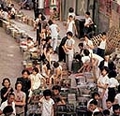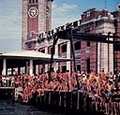
************************************************************
An exhibition that reveals life in Hong Kong during the 1960s and 1970s will be held at the Foyer of the Hong Kong Museum of History from next Wednesday (March 31) to June 14.
The "Memories We Share: Hong Kong in the 1960s and 1970s" exhibition features a rich collection of photographs and video footage, taking visitors, especially today's youngsters, back to Hong Kong at this pivotal time to trace the many and varied facets of the life of previous generations.
The 1960s and 1970s were a pivotal period of development in post-war Hong Kong. As the territory's population grew and the economy flourished, the people of Hong Kong began to experience a lifestyle that, in both material and spiritual terms, was becoming increasingly sophisticated, leading to a growing awareness of and quest for a distinctive local identity. Many facets of life in the 1960s and 1970s have become the collective memories of Hong Kong people.
Mini-skirts, bell-bottom trousers and platform shoes are typical icons of 60s and 70s fashion. Hong Kong's textile industry underwent significant developments during that period. The influence of Western culture and celebrities changed the face of fashion in the city. Young women began wearing miniskirts and hot pants, while bell-bottom trousers distinguished the trendiest men. Denim became a must-have item in young people's wardrobes. As new hairstyles emerged, wigs also became immensely popular. At the same time, large Japanese department stores opened in Hong Kong, created a niche market for Japanese clothes. These developments in the fashion industry would go on to inspire the trends of the 1980s.
Hong Kong has long enjoyed international renown for the wide range of cuisines available in the city. As early as the 1960s, a great variety of eateries offered the people of Hong Kong a large selection of dining options, from up-market Chinese and Western-style restaurants to "dai pai dong" (food stalls) out on the street. As commerce and industry flourished, Hong Kong's workforce grew, caterers began delivering lunch along with cutlery to offices and factories. The lunch box emerged and a fast food culture began to take root. Supermarkets began to spring up in the 1970s, with the earliest stores operating in Central. Hong Kong's "in" crowd frequented lounges and restaurants in famous hotels, while outside on the streets the crowds savoured "aeroplane" olives, "ding ding" ginger sweets, malt candies, sugar and coconut wraps and other snacks.
After the Second World War, a large number of immigrants flooded into Hong Kong from Mainland China, building makeshift homes in the hills or on the outskirts of the city. In 1953, a huge blaze that broke out in Shek Kip Mei prompted the government to build resettlement areas. In 1965, the fourth generation of resettlement areas with 16-storey buildings was built, and one million people lived in resettlement areas at that time. In the 1960s, water supplies were frequently restricted in Hong Kong, and scenes of long queues on the streets as people lined up, buckets in hand, to get water form part of the city's collective memory. In the 1970s, the Hong Kong government initiated its Ten Year Housing Plan, which drove the development of new towns such as Sha Tin and Tuen Mun. As Hong Kong's middle class was growing, private residential estates with excellent facilities were developed to meet their housing needs. Hong Kong's general housing situation had improved significantly since the 1950s.
Man-powered transport quickly became a thing of the past when the streets were taken over by motor vehicles in the 1960s and 1970s. Public transport was provided by buses and trams. As modern means of transportation were introduced and road tunnels were built, Hong Kong citizens had more and more options to choose from. In 1967, Hong Kong's first road tunnel, the Lion Rock Tunnel, was opened; in 1969, minibuses plying their trade in the New Territories were granted official licences; in 1982, trains switched from diesel to electric. The Cross Harbour Tunnel opened in 1972, and in 1979 the Mass Transit Railway (MTR) went into operation. Improvements to transport services crossing Victoria Harbour gradually turned the "wala wala" (small boat) into a distant memory, while the Star Ferry lost its role as the primary means of cross-harbour travel.
The population of Hong Kong surged by 2.4 million people in just over a decade after the Second World War, but government social welfare policies failed to keep up with the increasing demands made on social services. And, influenced by political movements in Mainland China, a succession of resistance campaigns were launched in Hong Kong. A hike in the fare for the Star Ferry provoked demonstrations in 1966, while in 1967, at the height of the Cultural Revolution in China, a labour strike at an artificial flower factory in San Po Kong sparked riots. In 1971, university students launched a campaign to defend Chinese sovereignty over the Diaoyutai Islands, and in 1973 they organised demonstrations to protest against corruption typified by the Godber scandal. These campaigns mark the contours of this volatile period of Hong Kong's history. The social movements of the 1960s presented an opportunity for the Hong Kong government to give greater consideration to youth issues. District offices under the Home Affairs Department were then set up across Hong Kong to facilitate communication between the government and citizens. Public facilities such as football fields, basketball courts and swimming pools were built and funds were allocated for medical services and social benefits. The Independent Commission Against Corruption was established to fight corruption and reduce tensions in society.
In the 1960s, traditional forms of entertainment such as street performances, comic book stands, sweepstakes and the "tse fa" lottery remained hugely popular. The annual Cross-Harbour Swimming Race held in Victoria Harbour and the Hong Kong Brands and Products Expo were also major attractions. However, after the transistor radio reached the market in 1957, and Hong Kong Commercial Broadcasting Company (Commercial Radio) was established in the same year, radio broadcasts became the main form of entertainment for Hong Kong citizens. In 1967, Television Broadcasts Limited (TVB) started operations, and after colour TV became available in 1971, television dramas quickly captured a keen audience. As well as launching the careers of TV personalities, television broadcasts were largely responsible for the rise of Cantonese pop music (Cantopop). Rebuilt in 1962, Hong Kong City Hall affirmed the government's commitment to bringing culture to the territory through facilities such as public libraries, museums and performance venues. The activities and exhibitions held at City Hall injected great vibrancy into Hong Kong's cultural life.
Admission is free to the "Memories We Share: Hong Kong in the 1960s and 1970s" exhibition, held at the Foyer of the Museum of History.
The Museum of History is located at 100 Chatham Road South, Tsim Sha Tsui, Kowloon. It opens from 10am to 6pm from Monday to Saturday and from 10am to 7pm on Sundays and public holidays. It is closed on Tuesdays (except public holidays). Admission to the galleries is $10 and a half-price concession is available to full-time students, senior citizens and people with disabilities. Admission is free on Wednesdays.
For details of the exhibition, please visit the Museum of History's website at hk.history.museum or call 2724 9042.
Ends/Friday, March 26, 2010
Issued at HKT 17:48
NNNN







